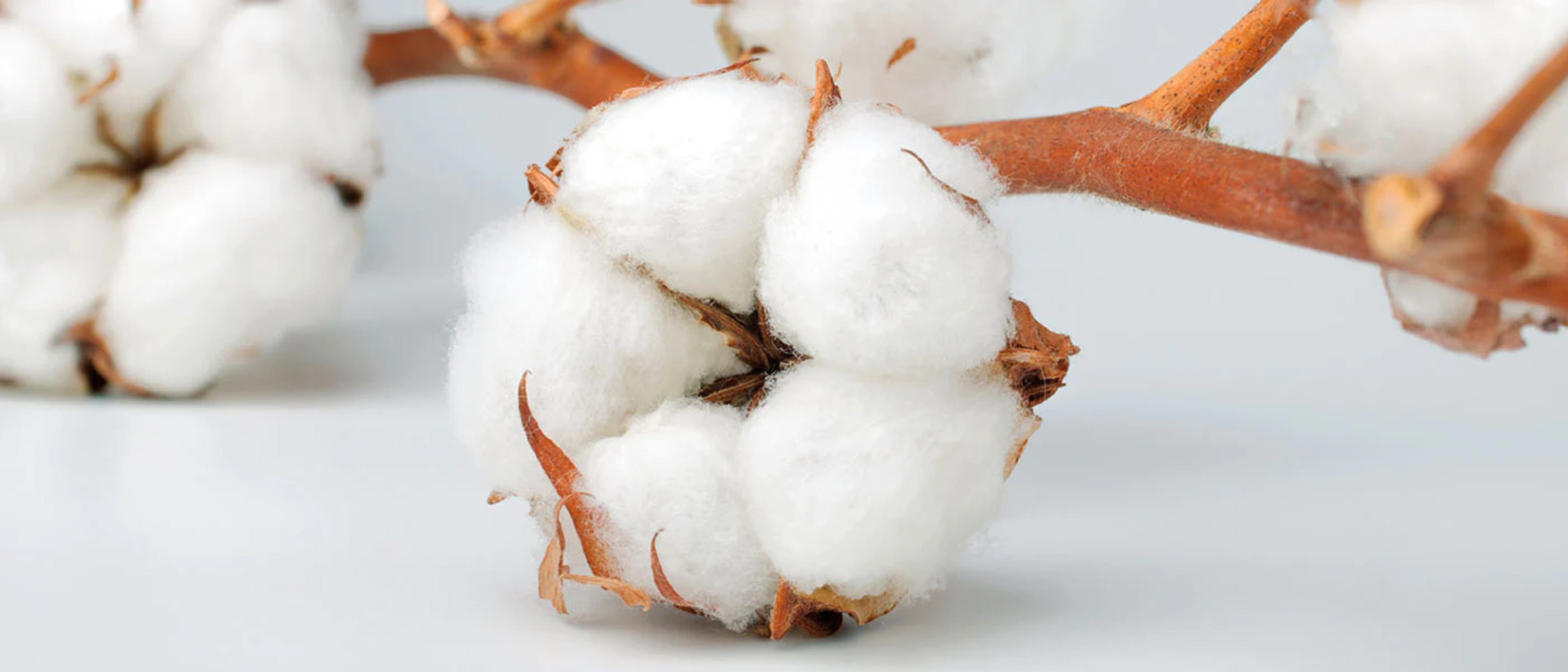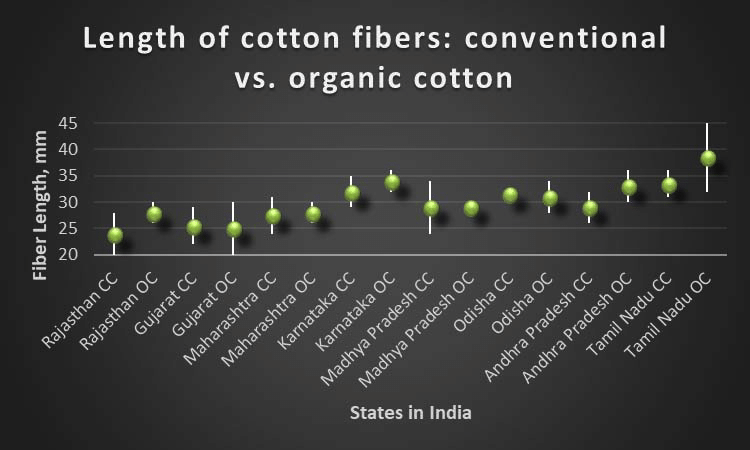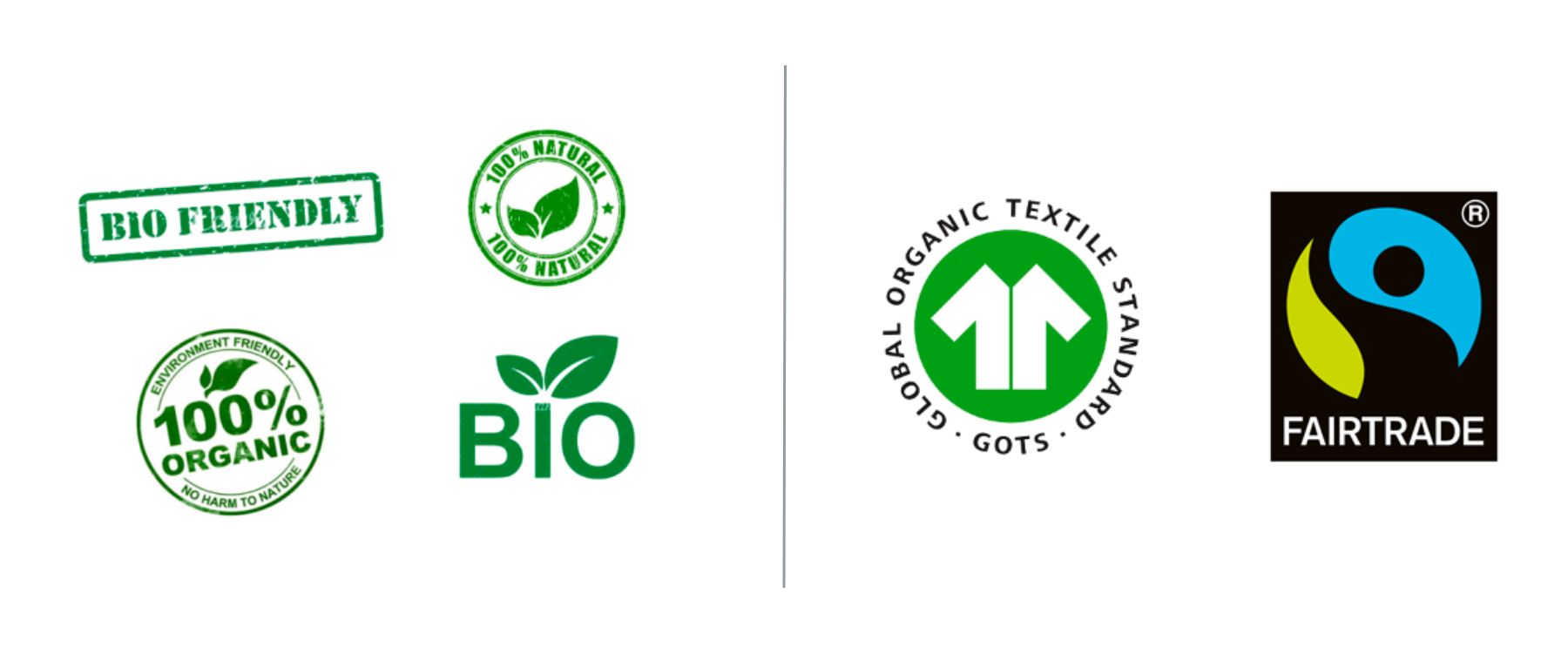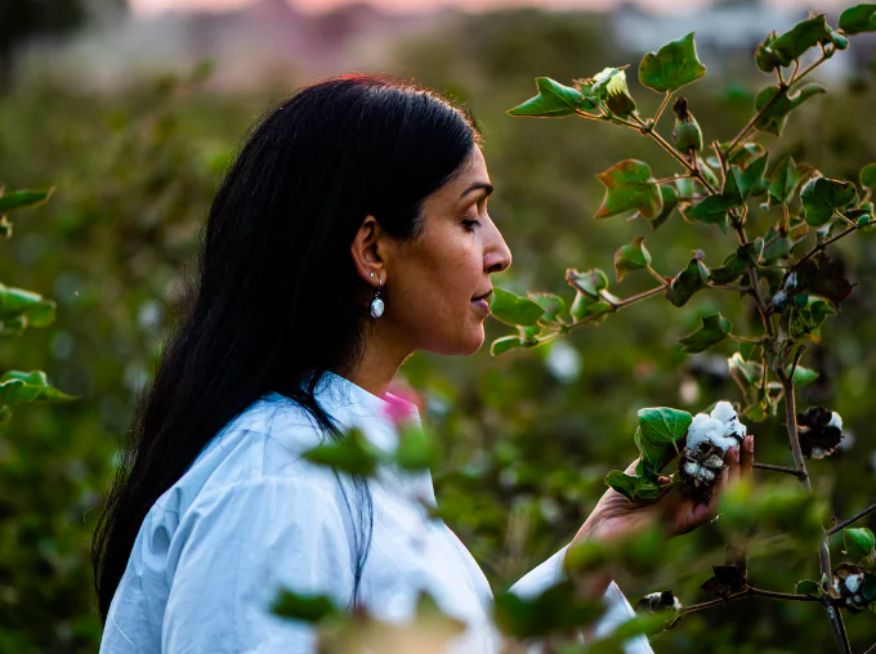


By Vinita Baravkar

Organic cotton is significantly more sustainable and safer than other commercially-produced fibres since it's grown without artificial fertilisers or toxic pesticides. Conventional cotton (also known as regular cotton) production involves harmful synthetic chemicals that can be catastrophic for the environment and human health.
However, comparing a standard cotton t-shirt priced at $20 (or less) to an organic cotton t-shirt, the latter can cost up to two or three times more. Is the price difference justifiable?
Despite its higher price tag, choosing organic cotton over regular cotton is worth it. The premium is nothing when compared to the lasting benefits that come with it.
Although sceptics argue organic cotton uses more water during production (compared to the yields) and aren't significantly more resource-efficient than its conventional counterpart.
In addition to the confusing water debate, the cotton industry contains a lot of smoke and mirror marketing. Many regular cotton products insist on being eco-friendly, but this often isn't true — there's little to no proof of such claims.
Bhumi has worked in the cotton industry since 2017. The founders, Dushyant and Vinita Baravkar, routinely visit their production partners in rural India to understand the entire supply chain of certified organic cotton.
Bhumi knows first-hand the challenges the cotton industry faces and the confusion it causes.
This guide will help you bypass the greenwashing and get the facts, so you can feel confident when considering any product made from cotton.
But first, why should you care about cotton?
Cotton is a natural plant fibre that grows around the cotton plant's seed. The top cotton-producing countries are China, India, and the United States. Together they contribute approximately 50-60% of the world's production. India, however, dominates the organic cotton market, responsible for 38% of the global supply.
In 2021/2022, worldwide cotton production was approximately 120 million bales or 25 million metric tons. About half of all textiles are made from cotton, making it the most utilised non-food crop.
The cotton industry employs over 250 million people and provides income for millions of families in developing countries. In fact, almost 7% of all labour in developing countries is employed by the cotton industry.
According to a report by PR Newswire, the global cotton market was US$38.54 in 2020 and is expected to reach US$46.56 Billion by 2027.
With such high demand, big corporations scramble for market share, creating issues in ethics, workers' rights, production practices and sustainability.
No wonder cotton is regularly called the dirtiest crop in the world. Is organic cotton the solution?
Organic cotton is grown from non-genetically modified plants without using synthetic agricultural chemicals such as fertilisers or pesticides. It doesn't rely on irrigation, making it a much more sustainable and eco-friendly alternative to conventional cotton.
Growing organic cotton requires specific standards and practices for certification. Starting with the seed, the cotton must be developed on land free from synthetic pesticides, insecticides, fertilisers, genetically modified organisms (GMOs), growth regulators, and other toxic products for three years.
During this process, crop rotation is necessary to maintain soil fertility. Once the organically grown cotton is harvested, it can be processed. Processing includes ginning (removing seeds from fibres) and spinning (spools of raw yarn).
After this point in the production chain, there are additional stages including
Scrupulous record-keeping throughout these steps must be observed to ensure the integrity of the organic cotton product.
Organic cotton isn’t grown commercially in Australia due to the high start-up costs, lack of infrastructure, and a general tendency towards conventional farming practices.
Additionally, converting a conventional farm to organic would take at least seven years to leech off all the chemicals used in traditional farming. Water usage in Australia is already a major concern due to droughts.
With these challenges, importing organic cotton makes more economic sense than attempting to produce it.
Organic cotton is touted as an eco-friendly alternative to traditional cotton. But it also has many other benefits, including quality, social and health advantages.
Organic cotton is known for its high quality. As it’s grown without synthetic pesticides or fertilisers, it has a softer feel and is less likely to cause skin irritation than conventional cotton.
Furthermore, organic cotton fibres are longer and stronger than non-organic fibres, which means they are more durable and can withstand more wear and tear.

[Caption: Length of the fibres: conventional vs. organic cotton - Source]
Bhumi customers rave about the softness and durability of its organic cotton products.
One customer, Florence said, "Love them - such high quality sheets that feel great and not easily creased. Luxury feel that provides a great nights sleep.”
Another customer, Chinwei shared, "Luxury at home! I love every single one of my Bhumi products, the fabrics are so beautiful and comfortable."
So if you're looking for a more comfortable and long-lasting bedding, bath or apparel option, consider switching to organic cotton. Your skin will thank you.
Read more: The Best Materials For Your Bed Sheets

Organic cotton is grown using methods and materials with a low environmental impact, replenishing and maintaining soil fertility while avoiding harmful pesticides and chemicals.
Embracing nature's gifts, organic cotton farmers ingeniously utilise renewable resources like monsoon rain and sustainable irrigation techniques to nourish their crops in harmony with Mother Earth.
Take India, the world's largest producer of organic cotton. Farmers have reduced their climate impact by up to 50% in India's Madhya Pradesh region by switching to organic cotton farming methods.
By avoiding synthetic pesticides and fertilisers, organic farming creates a more natural environment that supports a broader range of plant and animal life.
Organic cotton production has broader environmental benefits as well. It helps to reduce water pollution by avoiding toxic chemicals that can contaminate water sources. It also reduces greenhouse gas emissions by promoting healthier soil that sequesters carbon.
Soil Association reports that organic cotton generates 46% fewer greenhouse gas emissions than conventional cotton by avoiding synthetic fertilisers and pesticides.
Organic cotton provides several social benefits, particularly related to labour. In Bhumi’s most recent visit to rural India to meet with their suppliers, the team validated once again that organic cotton farming provides economic opportunities for local communities.
By avoiding expensive chemical inputs and relying on traditional farming techniques instead, farmers can save money while still producing high-quality crops.
Babu-ji, a farmer located in the state of Madhya Pradesh (India), stated:
“Organic farming has allowed us to become self-sufficient as a family and broadly as a community.
We are no longer dependent on resources provided by external entities who put their own commercial interests first - instead we are using our own traditional knowledge and resources to grow healthy crops, which benefits our local community and the health of our Mother earth.”
Bhumi also noted that organic cotton farming promotes social equity by empowering women in rural communities. Women are often involved in every aspect of the cotton production process – from planting and harvesting to processing and marketing – which allows them to play an active role in their local economies.

Organic cotton is a healthier option for supply chain workers and consumers alike. More specifically:
"Since we switched to organic farming, we no longer have to worry about the health risks associated with using pesticides and synthetic fertilisers. Our crops are healthier, our soil is richer, and our water is cleaner." - Srinivasan, a farmer Madurai, Tamil Nadu (India)
While organic cotton has many benefits, some challenges are associated with its production and accessibility. Let’s review some of the fundamental problems facing this industry.
One of the main arguments against organic cotton is that it yields less than conventional cotton, meaning more land is required to grow the same amount. However, this argument only tells part of the story.
While it's true that organic cotton yields are lower than conventional cotton yields, studies have shown that organic farming practices can lead to higher yields in drought years. What’s more, organic farming methods can improve soil health and biodiversity, leading to long-term sustainability and resilience.
According to a study, cotton yields were 14% lower in organic farms compared to conventional farms. But the study also found that organic farming systems had higher economic returns due to lower input costs and higher prices for organic cotton.
While organic cotton may have higher production costs due to using natural fertilisers and pest control methods, it can also fetch a higher price in the market due to its eco-friendly and sustainable nature.
According to a study by Kering & Textile Exchange in India, organic cotton producers receive 5-13% higher prices than those of conventional cotton. Organic farmers rely on more labour-intensive methods such as hand weeding and crop rotation, which can increase production costs.
Despite the growing demand for organic cotton, it represents less that 1% of global cotton production.
This limited availability can make it challenging for companies that want to source large quantities of organic cotton. It also presents difficulty for consumers who wish to purchase products made from organic cotton, as they may be harder to find or more expensive than non-organic alternatives.
Cotton is a fabric made from the fibres of the cotton plant. The fibres are twisted together to form threads woven into fabric. It’s widely used in clothing, bedding, towels, and other textiles.
Read more: What is the Best Thread Count For Sheets
Conventional cotton production is a process that requires highly chemical-dependent farming methods.
It begins with seeds grown in nutrient-depleted soil and exposed to large amounts of fertiliser, often damaging runoff and polluting local waterways. This is followed by introducing insecticides and pesticides to help ward off pests, many of which remain harmful to the environment, wildlife, and local communities.
After harvesting, the cotton is sent for processing, where dyes, chemicals and other treatments may be applied before the fabric is either knitted or woven together for use.
In comparison, organic cotton production involves non-invasive farming practices such as crop rotation, natural fertilisers, companion planting (the intermingling of different plant species), trap cropping, and natural colouring.
These methods are designed to protect and nurture essential organisms in the soil that are key to keeping soil healthy while also creating a safe environment for our farmers.
Organic cotton also undergoes much gentler processing, producing fabrics without hazardous chemicals such as chlorine bleach or formaldehyde.
Read more: From Farm to Fabric: How Cotton is Made
Regular cotton has several commercial benefits, making it the popular choice for clothing and textile production. As you'll soon see, the running theme comes down to price, volume and access — virtually the opposite of the challenges of organic cotton.
Regular cotton is typically less expensive than organic cotton because it requires fewer labour-intensive processes and inputs. This makes it a more affordable option for consumers.
Conventional cotton farming methods often produce higher yields than organic farming due to synthetic fertilisers that immediately boost plant growth. This means that farmers can generate more cotton per acre, which can help improve their economic viability.
Regular cotton is widely available and easily accessible from many sources worldwide, making it easy for manufacturers to source large quantities. Organic cotton, on the other hand, is often produced in smaller quantities and may be harder to find.
It's important to note that while conventional cotton creates a more convenient and cost-effective option when it hits the shelves, its production comes at a high cost to the environment, wildlife and surrounding communities.
Cotton is one of the most widely grown crops in the world, and conventional cotton production has been a major contributor to environmental degradation, social injustice, and health concerns.
Cotton farming involves clearing large land areas, leading to soil erosion and degradation. The topsoil becomes depleted of organic matter, decreasing its ability to hold water. This results in reduced fertility and productivity of the land over time.
Cotton farming requires a significant amount of water, which can lead to water scarcity in regions where it’s grown.
Moreover, pesticides and fertilisers contaminate nearby water sources such as rivers and lakes. This toxic runoff can harm aquatic life and pose health risks to humans who rely on these water sources.
The production of conventional cotton contributes to greenhouse gas emissions through synthetic fertilisers, transportation, and energy-intensive manufacturing processes. Using synthetic fertilisers releases nitrous oxide, a potent greenhouse gas 300 times more damaging than carbon dioxide.
According to WWF, it takes 2,700 litres of water to produce one cotton shirt, which results in approximately 6 kg of CO2 emissions per shirt.
Forced and child labour is a pervasive problem in the cotton industry, with children as young as 10 and 11 years old forced to work long hours in extreme temperatures. Shockingly, many child cotton labourers receive little or no pay, and those who do are often paid well below the minimum wage.
According to World Vision, in Gujarat, India, a child working on a cotton seed farm earns less than A$1 per day. This meagre income is barely enough to survive and perpetuates a cycle of poverty that keeps children locked into exploitative work conditions.
In Uzbekistan, children are made to work from early morning until evening without sufficient food. This practice violates their fundamental human rights and exposes them to physical harm and psychological trauma.
The heavy use of pesticides (4.74% of global sales) and insecticides (10.24% of global sales) in conventional cotton farming has been linked to numerous health concerns for farmers and consumers alike.
These chemicals can cause skin irritation, respiratory problems, neurological damage, cancer, and other serious health issues.
In India's Punjab region, farmers have reported increased rates of cancer due to exposure to pesticides used in conventional cotton farming.
Organic and conventional cotton differ in how they are grown, harvested, and processed. Below is a direct comparison of the differences.
| Aspect | Organic Cotton | Conventional Cotton |
|---|---|---|
| Seed preparation | Relies on non-GMO seeds that free from synthetic fertilisers and pesticides and aren’t genetically modified. Farmers may save their seeds or purchase them from certified organic sources to guarantee they haven't been tampered with. | GMO seeds are often used in conventional cotton farming to increase yield and resistance to pests. These seeds are treated with synthetic fertilisers and pesticides, which can lead to genetic modification and contamination of soil and water systems. |
| Soil Preparation | Improves soil health by relying on natural fertilisers like composted manure, cover crops, crop rotation, green manure and other plant-based materials to keep the soil ecosystem balanced. | Uses synthetic fertilisers that contain high levels of nitrogen or phosphorus. |
| Weed Control | Use natural methods such as hand weeding or mechanical tillage instead of chemical herbicides that can harm other plants or wildlife around the farm area. Some organic farmers also use mulching techniques to cover the base of their crops with organic matter such as straw or leaves so that weeds do not grow easily around them. | Relies on herbicides containing toxic chemicals like glyphosate that kill all plants except GMOs. |
| Harvesting | Usually handpicked because it’s more delicate than conventional cotton fibres, which require machine harvesting due to its rougher texture. Handpicking reduces damage done to fibres during harvest, thus producing higher-quality fibre while preventing waste. | Machine harvesting for conventional cotton is faster but results in a lower-quality thread due to damage during the harvest process leading to waste. |
| Production | Yields less than regular cotton production due to reduced use of chemical inputs, resulting in better quality fibre lasting longer than conventionally produced fibre. | Often results in higher yields but lower quality fibre because they rely heavily on chemical inputs. |
| Whitening | Hydrogen peroxide or ozone washes are commonly used for organic fabric whitening processes; these processes don't produce harmful wastewater like chlorine bleach. | Chlorine bleach is widely used for conventional fabric whitening processes; chlorine bleach releases toxic pollutants into waterways affecting aquatic life. |
| Finishing | Natural materials such as starch can be used for finishing organic fabrics instead of harsh chemicals found in conventional fabric finishing processes. | Synthetic chemicals like formaldehyde are commonly used for finishing conventionally produced materials; these substances pose risks both human health risks during the production process while polluting landfills when disposed after usage. |
| Dyeing | Low-impact dyes made from natural substances such as clay pigments are the preferred dyeing method for organic fabrics since they do not contain heavy metals nor release harmful toxins into waterways when washed off during laundering processes. | Synthetic dyes containing heavy metals such as cadmium, mercury or lead are commonly used for dyeing conventionally produced fabrics. |
| Printing | Water-based ink free from toxic solvents is the preferred method when printing onto organic fabrics since no harmful pollutants are released into the environment during the washing-off process after usage. | Petroleum-based printing ink containing toxic solvents is usually used when printing onto conventionally produced fabrics; these substances pollute both air and waterways, causing environmental hazards. |
| Fairtrade | Organic certification organisations employ fairtrade principles ensuring workers receive reasonable wages and working conditions on top of promoting sustainable agricultural practices. | No certification process exists to ensure fairtrade principles nor promoting sustainable farming practices, thus exposing workers to health risks associated with pesticide exposure. |
| Price | Generally more expensive than conventional cotton due to the higher cost of production. The lack of synthetic fertilisers and pesticides means farmers must use more manual labour, which increases costs. | Normally less expensive than organic cotton due to its reliance on synthetic fertilisers and pesticides, which are cheaper and easier to apply than natural alternatives. |
| Packaging | Often packaged using eco-friendly materials like recycled paper or biodegradable plastics. This helps reinforce the sustainability message associated with organic cotton and reduce the environmental impact of packaging waste. | May be packaged using various materials, including plastic bags or cardboard boxes. While some efforts have been made to reduce packaging waste associated with conventional cotton, it's still common for these products to be packaged in non-sustainable materials. |
Even though organic cotton typically challenges farmers with higher labour costs and a decreased yield rate compared to regular cotton suppliers, it often becomes more profitable since its current value is much higher than that of mass-produced fabric.
On top of that, when you factor in prevailing weather conditions or input cost variations from season to season, the fixed premium gap between organic and conventional market prices dissipates.
Ultimately, any additional cost incurred by the consumer pales in comparison to the widespread benefits of using organic cotton — benefits ranging from reduced human health impacts due to harmful pesticide usage and improved farming communities.
As consumers become increasingly conscious of their environmental impact, many companies jump on the "green" bandwagon to appeal to those prioritising sustainability.
Unfortunately, not all claims of eco-friendliness are accurate or transparent, and cotton is no exception. Below are examples of cotton greenwashing to put on your radar.
Companies can use these buzzwords on product labels to imply that the cotton is minimally processed and, therefore, more eco-friendly. However, they don't necessarily indicate how the cotton was grown or harvested and can be misleading if not backed up by specific certifications or information about production methods.

The Better Cotton Initiative (BCI) is a certification program that aims to improve sustainability in the cotton industry.
However, some brands may use BCI certification to suggest that their cotton is fully sustainable when BCI standards still allow for some pesticide and synthetic fertiliser use.
Some brands may market their cotton as "Australian" to suggest it's more sustainable or ethical. While Australia has pesticide use regulations, this doesn't necessarily mean that the cotton is organic or produced using sustainable methods.
While recycled materials can be more sustainable than virgin materials, some brands advertise their products as "recycled" without disclosing what percentage of the fabric is made from recycled materials.
Brands may use biodegradable or compostable packaging to convey an eco-friendly image, but this doesn't necessarily reflect anything about the sustainability of the actual product.
As we’ve established, certified organic cotton is cotton that has been grown without synthetic fertilisers or pesticides. This type of cotton is considered more sustainable and ethical than conventionally grown cotton because it promotes healthier soil, water, and air quality.
It doesn’t stop there.
Certified organic cotton farming practices prioritise worker safety and fair labour conditions.
If you're looking for textiles made from certified organic cotton, there are a few things to remember. First, look for products certified by reputable organisations such as the Global Organic Textile Standard (GOTS) or the Organic Content Standard (OCS).
These certifications ensure the product meets specific environmental and social criteria throughout its supply chain.
Another way to identify textiles made from certified organic cotton is to look for labels or tags on the product itself. These labels may include information about the certification organisation and details about the percentage of the organic cotton used in the product.
It's important to note that not all products labelled "organic" are necessarily made from certified organic cotton. Some companies may use vague or misleading language on their packaging to make their products appear more eco-friendly than they are.
Always look for third-party certifications and research before purchasing to avoid falling for greenwashing tactics.
Organic cotton is better for the environment, our health, and the communities involved in its production.
By choosing organic cotton over conventional cotton, we can reduce our impact on the planet and support sustainable agriculture.
Bhumi is committed to providing high-quality certified organic cotton and ethical and eco-friendly products. Join them in making a difference by choosing Bhumi's organic cotton products for your home and wardrobe today.

RELATED ARTICLES

